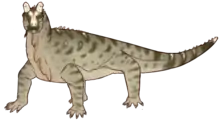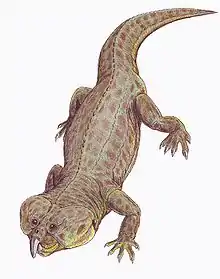Zanclodon
Zanclodon ("scythe tooth") is an extinct genus of archosauriform found in Middle Triassic deposits in southern Germany.[1]
| Zanclodon | |
|---|---|
| Scientific classification | |
| Kingdom: | Animalia |
| Phylum: | Chordata |
| Class: | Reptilia |
| Clade: | Archosauria |
| Genus: | †Zanclodon Plieninger, 1846 |
| Type species | |
| †Smilodon laevis Plieninger, 1846 | |
Taxonomy
Zanclodon was originally named Smilodon by Plieninger (1846), but this name had previously been used for the saber-toothed cat (a preoccupied name), prompting Plieninger to erect the replacement name Zanclodon.[2] It was formerly placed in the Teratosauridae, within the Theropoda, and at times, plateosaurid material was mistakenly referred to Zanclodon (see Galton 2001). The type species, Zanclodon laevis, is based on a left maxilla that represents an indeterminate archosaurian. Therefore, the genus is not unambiguously identifiable.[3]
Species
- Z. laevis (Plieninger, 1846) [originally "Smilodon"] (type)
- Z. crenatus (Plieninger, 1846) [originally "Smilodon"]
- Z. bavaricus (Fraas, 1894 vide Sandberger, 1894) = Sauropodomorpha incertae sedis[3]
- Z. plieningeri (Fraas, 1896) = junior synonym of Z. laevis[3]
- Z. arenaceus (Fraas, 1896) = a possible parasuchian[4][5]
- Z. cambrensis (Newton, 1899) = '"Newtonsaurus" (Welles & Pickering, 1993) – nomen nudum, known from a lower jaw with teeth preserved as a mould in South Wales, Theropoda indet.
- Z. schutzii (Fraas, 1900) = Batrachotomus
- Z. silesiacus (Jaekel, 1910) = nomen dubium at Archosauromorpha indeterminate[6][7]
References
- PaleoBiology Database: Zanclodon, basic info
- Plieninger, T. (1846). Über ein neues Sauriergenus und die Einreihung der Saurier mit flachen, schneidenden Zähnen in Eine Familie [On a new saurian genus and incorporating the saurian with flat, cutting teeth into a family]. Jahreshefte des Vereins für Vaterländische Naturkunde in Württemberg 2: 148-154.
- Galton, P.M. (2001). The prosauropod dinosaur Plateosaurus Meyer, 1837 (Saurischia: Sauropodomorpha; Upper Triassic). II. Notes on the referred species. Revue de Paléobiologie, Genève 20(2): 435–502.
- Hungerbühler, A. (2001). The status and phylogenetic relationships "Zanclodon" arenaceus: the earliest known phytosaur? Paläontologische Zeitschrift 75(1): 97–112.
- Schoch, R.R. 2002. Stratigraphie und Taphonomie wirbeltierreicher Schichten im Unterkeuper (Mitteltrias) von Vellberg (SW-Deutschland). Stuttgarter Beiträge zur Naturkunde (B) 318: 1–30.
- Carrano, M.T.; Benson, R.B.J.; & Sampson, S.D. (2012). "The phylogeny of Tetanurae (Dinosauria: Theropoda)". Journal of Systematic Palaeontology 10(2): 211–300
- Skawiński, T.; Ziegler, M.; Czepiński, Ł.; Szermański, M.; Tałanda, M.; Surmik, D. & Niedźwiedzki, G. (2017). "A re-evaluation of the historical 'dinosaur' remains from the Middle-Upper Triassic of Poland". Historical Biology. 27 (4): 442–472. doi:10.1080/08912963.2016.1188385.CS1 maint: uses authors parameter (link)
- Fraas, E. (1900). Zanclodon schützii n. sp. aus dem Trigonodusdolomit von Hall [Zanclodon schützii n. sp. from the Trigonodus-dolomite of Halle]. Jahreshefte des Vereins für Vaterländische Naturkunde in Württemberg 56: 510–513.
- Hagdorn, H. & Mutter, R.J. (2011). The vertebrate fauna of the Lower Keuper Albertibank (Erfurt Formation, Middle Triassic) in the vicinity of Schwäbisch Hall (Baden-Württemberg, Germany). Palaeodiversity 4: 223–243.
- Jaekel, O. (1910). Ueber einen neuen Belodonten aus dem Buntsandstein von Bernburg [On a new belodontid from the Buntsandstein of Bernburg]. Sitzungsberichte der Gesellschaft Naturforschender Freunde zu Berlin 1910 (5): 197-229
- Newton, E.T. (1899). On a megalosaurid jaw from Rhaetic beds near Bridgend (Glamorganshire). Quarterly Journal of the Geological Society of London 55: 89–96.
- Schoch, R.R. (2011). New archosauriform remains from the German Lower Keuper. Neues Jahrbuch für Geologie und Paläontologie, Abhandlungen 260: 87-100. doi:10.1127/0077-7749/2011/0133.
This article is issued from Wikipedia. The text is licensed under Creative Commons - Attribution - Sharealike. Additional terms may apply for the media files.







